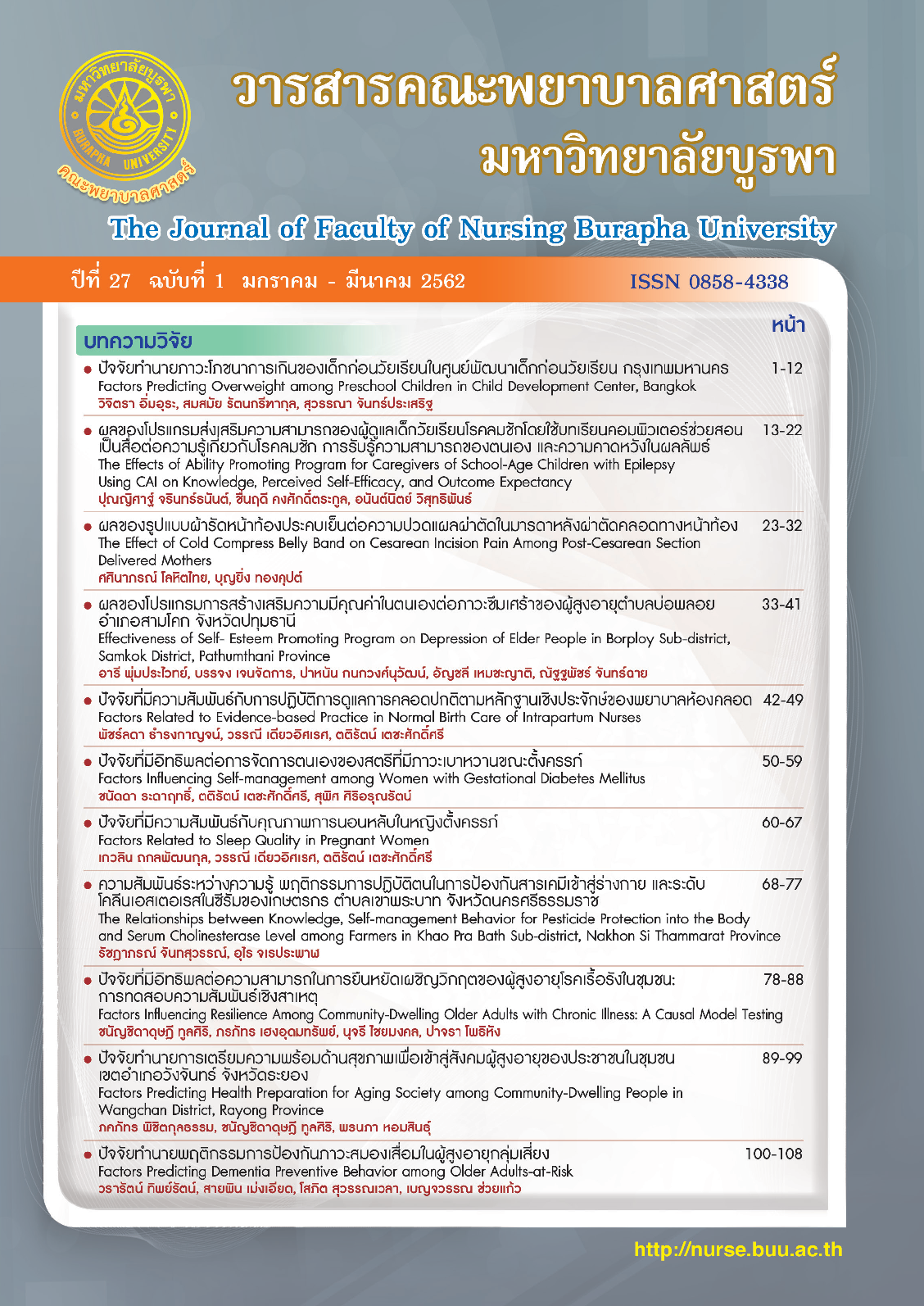ผลของรูปแบบผ้ารัดหน้าท้องประคบเย็นต่อความปวดแผลผ่าตัดในมารดาหลังผ่าตัดคลอดทางหน้าท้อง
คำสำคัญ:
ผ้ารัดหน้าท้องประคบเย็น, ระดับความปวด, มารดาหลังผ่าตัดคลอดทางหน้าท้องบทคัดย่อ
บทคัดย่อ
การวิจัยนี้เป็นแบบกึ่งทดลองกลุ่มเดียววัดผลก่อนและหลังการทดลอง มีวัตถุประสงค์เพื่อศึกษาผลของการใช้ผ้ารัดหน้าท้องประคบเย็นต่อความปวดแผลผ่าตัดในมารดาหลังผ่าตัดคลอดทางหน้าท้อง และความพึงพอใจของมารดาต่อการใช้ผ้ารัดหน้าท้องประคบเย็น กลุ่มตัวอย่างเป็นมารดาหลังผ่าตัดคลอดทางหน้าท้อง หอผู้ป่วยหลังคลอดโรงพยาบาลนราธิวาสราชนครินทร์ จำนวน 25 คน คัดเลือกโดยวิธีการสุ่มอย่างง่าย กลุ่มตัวอย่างได้รับผ้ารัดหน้าท้องประคบเย็นหลังผ่าตัดคลอดครบ 8 ชั่วโมง เครื่องมือวิจัยประกอบด้วยแบบบันทึกข้อมูลทั่วไป แบบประเมินความปวด และแบบสอบถามความพึงพอใจ วิเคราะห์ข้อมูลด้วยใช้สถิติพรรณนาและการทดสอบความแปรปรวนทางเดียวแบบวัดซ้ำ
ผลการวิจัย พบว่ากลุ่มตัวอย่างมีค่าเฉลี่ยความปวดในระยะก่อน ระยะหลังใช้ผ้ารัดหน้าท้องประคบเย็นทันที และระยะหลังใช้ผ้ารัดหน้าท้องประคบเย็นในชั่วโมงที่ 4, 8, 12 และ 16 แตกต่างกันอย่างมีนัยสำคัญทางสถิติ (p<.001) และในระยะหลังใช้ผ้ารัดหน้าท้องประคบเย็น กลุ่มตัวอย่างมีค่าเฉลี่ยความปวดแผลผ่าตัดคลอดทางหน้าท้องลดลงอย่างต่อเนื่องอย่างมีนัยสำคัญทางสถิติ กลุ่มตัวอย่างมีระดับความพึงพอใจต่อการใช้ผ้ารัดหน้าท้องประคบเย็นโดยรวมอยู่ในระดับมาก ผลการวิจัยมีข้อเสนอแนะว่าพยาบาลสามารถนำผ้ารัดหน้าท้องประคบเย็นไปประยุกต์ใช้ควบคู่กับการใช้ยาตามแผนการรักษาเพื่อเพิ่มประสิทธิภาพในการบรรเทาปวดได้
เอกสารอ้างอิง
Baston, H., & Hall, J. (2017). Midwifery Essentials: Labour, Volume 3, Edition 2. London, UK:
Elsevier.
Chongjarean, A., & Teanlow, S., (2015). The effect of planned pain management on pain and satisfaction with pain management of patients with abdominal surgery at Chon Buri hospital. The Journal of Faculty of Nursing, Burapha University, 23(2), 76-90. [In Thai]
Chou, R., Gordon, D. B., Leon-casasola, O. A., Rosenber, J. M., Bickler, S., Brennan, T., & et al. (2016). Management of postoperative pain: A clinical practice guideline from the American pain society, the American society of regional anesthesia and pain medicine, and the American society of anesthesiologists’committee on regional anesthesia, executive committee, and Administrative council. The Journal of Pain, 17(2), 131-157.
Department of Health. (2018). Thailand reproductive health database: Percentage of women aged of 15-49 who had a delivery by C-section. Retrieved from http://rhdata.anamai.moph.go.th/index.php/maternal/maternal11. [In Thai]
Department of Delivery. (2017). Delivery Report. Narathiwas: Naradhiwasrajanagarindra Hospital. [In Thai]
Duangpaeng, S., Baramee, J., & Sangsaikeaw, A. (2011). Factors influencing postoperative symptom clusters among persons undergone abdominal surgery. The Journal of Faculty of Nursing, Burapha University, 19(Supplement2), 119-130. [In Thai]
Eamchumprathip, S., Sae-Sia, W., & Khupantavee, N. (2012). Application of cold-press massage to exercise programmer and its effect on patients’ recovery from total knee replacement surgery. Thai Journal of Nursing Council, 27(3), 77-90. [In Thai]
Fidlds, H. L., Basbaum, A. I., & Heinricher, M. M. (2006). Central nervous system mechanism of pain modulation. In S. B. McMahon & M. Koltzenburg. (Eds.). Wall and Melzack’s
textbook of pain. (5th ed.) (pp. 107-124). Philadelphia: Elsevier-Churchill Living stone.
Kusuwan, N. (2012). Effectiveness of Nongjan belly band on comfortable among mothers in the post-operativeperiod of cesarean section: Research report Damnoen Saduak Hospital. Retrieved from http://www.gj.mahidol.ac.th/tech/FileDownload/File/D150511175633.pdf. [In Thai]
Lumpikanon, P. (2018). Decreasing unknown cause of the cesarean section rate in Thailand. Retrieved from https://www.hfocus.org/content/2018/02/15385. [In Thai]
Melzack, R., & Wall, P.D. (1965). Pain mechanisms: A new theory. Science, 150(3669), 971-79.
Morakot, L., & Jitpanya, C. (2008). The effect of patient education and cryotherpy on post-operative pain of patients with lower limb fractures. Journal of Nursing Science Chulalongkorn University, 20(1), 41-53. [In Thai]
Mousavi, S. A., Mortazavi F., Chaman, R., & Khosravi, A. (2013). A quality of life after cesarean and delivery. Oman medical journal, 28(4), 245-251.
Phumdoung, S. (2016). Maternity and child nursing (1st ed). Songkla: Chanmuang. [In Thai]
Pinchaleaw, D., & Bhoosahas, P. (2015). Factors related to women’s distress after cesarean
section. Journal of The Royal Thai Army Nurses, 16(1), 101-108. [In Thai]
Refaie, A. M., Zakaria, M. A., Mohammed, H. A., & Hammour, E. M., (2018). Comparative
study between intravenous paracetamol and pethidine as post-cesarean section analgesia. The Egyptian journal of hospital medicine, 71(6), 3314-3321.
Sansiriphun, N., Baosoung, C., Yimyam, S., Sriarporn, P., & Srisawang, J. (2017). Nursing
obstetrics complication during pregnancy. Chiang-Mai: Smartcoating and service. [In Thai]
Serlin, V. R., Mendosa,T. R., Nakamura, Y., Edward, K., & Cleeland, C., S. (1995). When is cancer pain mild, moderate or severe?: Grading pain severity by its interference with function. Pain, 61, 277-284.
Srisatidnarakul, B. (2010). The Methodology in nursing research (5th ed). Bongkok: U & A
intermedia. [In Thai]
Siriwatpisit, B., & Mahawan, N. (2013). Effectiveness of belly band on pain level among mothers in the post-operative period of cesarean section: Research report of Pua Crown Prince Hospital. Retrieved from
http://www.med.cmu.ac.th/hospital/nis/downloads/?p=3305#more-3305. [In Thai]
World Health Organization. (2015). WHO statement on cesarean section rate every effort should be made to provide cesarean sections to women in need, rather than striving to achieve a specific rate. Retrieved from http://apps.who.int/iris/bitstream/handle/10665/161442/WHO_RHR_15.02_eng.pdf;jsessionid=16B6EA7655881E630F513B702FDEDE51?sequence=1.
William, D., Walton, D., & Plummer, Jr. (2011). PS - Power and Sample Size calculation online available: http://biostat.mc.vanderbilt.edu/wiki/Main/PowerSampleSize





